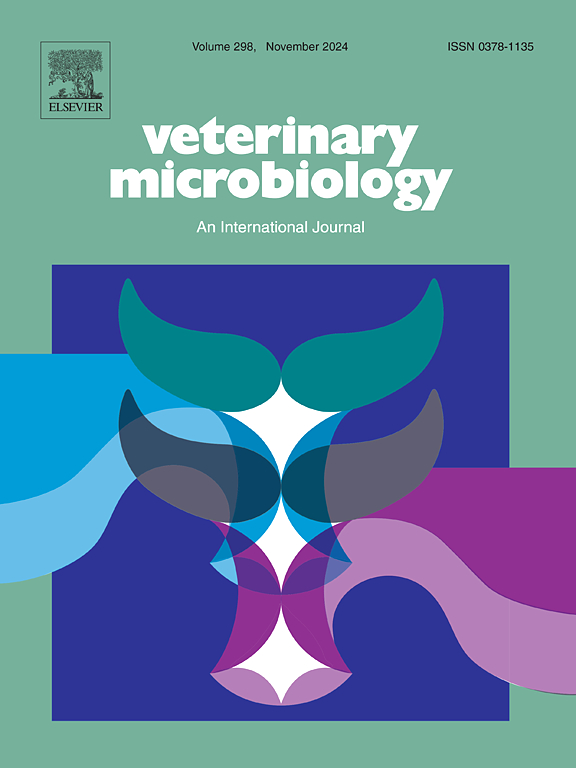Z-女贞苷通过 ACSL4-LPCAT3-POR 途径诱导铁变态反应,从而限制狂犬病病毒的复制
IF 2.4
2区 农林科学
Q3 MICROBIOLOGY
引用次数: 0
摘要
由狂犬病毒(RABV)诱发的狂犬病仍然威胁着全世界的健康,目前尚无有效的狂犬病治疗方法。最近,人们发现一系列天然植物成分可以抑制病毒的产生。本研究发现,川芎中的天然成分 Z-藁本内酯能抑制 RABV 的复制。最初,Z-女贞苷在 N2a 细胞和 BSR 细胞中的细胞毒性 50% 浓度(CC50)分别为 429.9 μM 和 335.5 μM,两者都以浓度依赖的方式显著限制了 RABV 的产生。此外,研究还发现 Z-女贞苷主要抑制 RABV 的复制阶段。具体来说,Z-女贞苷可通过直接抑制二酰甘油酰基转移酶 1/2(DGAT1/2)的表达来抑制脂滴(LD)的形成,从而进一步促进细胞脂质过氧化、Fe2+浓度、活性氧(ROS),并最终诱导铁变态反应。此外,Z-女贞苷还能通过酰基-CoA合成酶长链家族成员4(ACSL4)-溶血磷脂酰胆碱酰基转移酶3(LPCAT3)-细胞色素P450氧化还原酶(POR)途径增加铁变态反应。总之,这项研究探索了 Z-女贞苷的抗病毒功能,为开发抗 RABV 药物提供了新的视角。本文章由计算机程序翻译,如有差异,请以英文原文为准。
Z-Ligustilide restricts rabies virus replication by inducing ferroptosis through the ACSL4-LPCAT3-POR pathway
Rabies, induced by rabies virus (RABV), still threaten global health all over the world, and no effective therapy is available for rabies currently. Recently, a series of natural plant components have been found to inhibit virus production. In this study, Z-Ligustilide, a natural component of Ligusticum chuanxiong Hort, was found to inhibit RABV replication. Initially, the concentration of cytotoxicity 50 % (CC50) of Z-Ligustilide in N2a and BSR cells were 429.9 μM and 335.5 μM, respectively, which both significantly restrict RABV production in a concentration-dependent manner. Moreover, Z-Ligustilide was found to mainly inhibit the replication stage of RABV. Specifically, Z-Ligustilide can suppress lipid droplet (LD) formation via directly inhibiting diacylglycerol acyltransferase 1/2 (DGAT1/2) expression, which can further promote cellular lipid peroxidation, Fe2+ concentration, reactive oxygen species (ROS), and induce ferroptosis ultimately. Furthermore, Z-Ligustilide was demonstrated to increase ferroptosis via Acyl-CoA synthetase long-chain family member 4 (ACSL4)- Lysophosphatidylcholine Acyltransferase 3 (LPCAT3)- Cytochrome P450 Oxidoreductase (POR) pathway. Above all, this study explored the antiviral function of Z-Ligustilide, which provides a novel insight for developing anti-RABV drugs.
求助全文
通过发布文献求助,成功后即可免费获取论文全文。
去求助
来源期刊

Veterinary microbiology
农林科学-兽医学
CiteScore
5.90
自引率
6.10%
发文量
221
审稿时长
52 days
期刊介绍:
Veterinary Microbiology is concerned with microbial (bacterial, fungal, viral) diseases of domesticated vertebrate animals (livestock, companion animals, fur-bearing animals, game, poultry, fish) that supply food, other useful products or companionship. In addition, Microbial diseases of wild animals living in captivity, or as members of the feral fauna will also be considered if the infections are of interest because of their interrelation with humans (zoonoses) and/or domestic animals. Studies of antimicrobial resistance are also included, provided that the results represent a substantial advance in knowledge. Authors are strongly encouraged to read - prior to submission - the Editorials (''Scope or cope'' and ''Scope or cope II'') published previously in the journal. The Editors reserve the right to suggest submission to another journal for those papers which they feel would be more appropriate for consideration by that journal.
Original research papers of high quality and novelty on aspects of control, host response, molecular biology, pathogenesis, prevention, and treatment of microbial diseases of animals are published. Papers dealing primarily with immunology, epidemiology, molecular biology and antiviral or microbial agents will only be considered if they demonstrate a clear impact on a disease. Papers focusing solely on diagnostic techniques (such as another PCR protocol or ELISA) will not be published - focus should be on a microorganism and not on a particular technique. Papers only reporting microbial sequences, transcriptomics data, or proteomics data will not be considered unless the results represent a substantial advance in knowledge.
Drug trial papers will be considered if they have general application or significance. Papers on the identification of microorganisms will also be considered, but detailed taxonomic studies do not fall within the scope of the journal. Case reports will not be published, unless they have general application or contain novel aspects. Papers of geographically limited interest, which repeat what had been established elsewhere will not be considered. The readership of the journal is global.
 求助内容:
求助内容: 应助结果提醒方式:
应助结果提醒方式:


